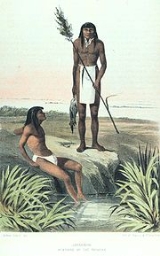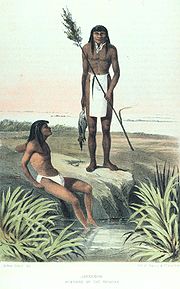
Hia C-ed O'odham
Encyclopedia
The Hia C-eḍ O'odham also known as Areneños, Sand Papagos, or Sand Pimas are a Native American
peoples whose traditional homeland lies between the Ajo Range, the Gila River
, the Colorado River
, and the Gulf of California
. They are currently unrecognized at both the state and federal level in the United States and Mexico, although the Tohono O'odham
Nation has a committee for issues related to them and has land held in trust for them. They are represented by a community organization known as the Hia-Ced O'odham Alliance. The Hia C-eḍ O'odham are no longer nomadic, and the majority today live in or near Ajo, Arizona
, or the small settlements of Blaisdell and Dome near Yuma
.
 They have often been considered a "Papago subtribe" by anthropologists, along with the Tohono O'odham
They have often been considered a "Papago subtribe" by anthropologists, along with the Tohono O'odham
and several vanished groups. The Tohono O'odham Nation has used this to their advantage in order to make various claims to aboriginal title to the traditional land of the Hia C-eḍ O'odham. The stated intentions of the Nation are benevolent, to re-enfranchise their Hia C-eḍ cousins and restore their traditional homeland. Anybody who can prove a certain percentage of Hia C-eḍ O'odham ancestry can apply for membership in the Tohono O'odham Nation.
was more Yuman than it was Piman, with the exception of their language. According to historical sources, the Hia C-eḍ O'odham were friendly with the Cocopah, the Quechan
, and the Halchidhoma
.
, and pronghorn antelope with bows and arrows. They caught muskrat
s and lizard
s as well. During certain seasons, they went to the gulf to fish and obtain salt.
They also ate camote, an edible flower stalk found in the sand dunes, mesquite beans, saguaro
fruit, and pitahaya fruit, which they gathered near Quitobaquito and the Lower Sonoita River.
Indigenous peoples of the Americas
The indigenous peoples of the Americas are the pre-Columbian inhabitants of North and South America, their descendants and other ethnic groups who are identified with those peoples. Indigenous peoples are known in Canada as Aboriginal peoples, and in the United States as Native Americans...
peoples whose traditional homeland lies between the Ajo Range, the Gila River
Gila River
The Gila River is a tributary of the Colorado River, 650 miles long, in the southwestern states of New Mexico and Arizona.-Description:...
, the Colorado River
Colorado River
The Colorado River , is a river in the Southwestern United States and northwestern Mexico, approximately long, draining a part of the arid regions on the western slope of the Rocky Mountains. The watershed of the Colorado River covers in parts of seven U.S. states and two Mexican states...
, and the Gulf of California
Gulf of California
The Gulf of California is a body of water that separates the Baja California Peninsula from the Mexican mainland...
. They are currently unrecognized at both the state and federal level in the United States and Mexico, although the Tohono O'odham
Tohono O'odham
The Tohono O'odham are a group of Native American people who reside primarily in the Sonoran Desert of the southeastern Arizona and northwest Mexico...
Nation has a committee for issues related to them and has land held in trust for them. They are represented by a community organization known as the Hia-Ced O'odham Alliance. The Hia C-eḍ O'odham are no longer nomadic, and the majority today live in or near Ajo, Arizona
Ajo, Arizona
Ajo is a census-designated place in Pima County, Arizona, United States. The population was 3,705 at the 2000 census. Ajo is located on State Route 85 just from the Mexican border. It is the closest community to Organ Pipe Cactus National Monument....
, or the small settlements of Blaisdell and Dome near Yuma
Yuma, Arizona
Yuma is a city in and the county seat of Yuma County, Arizona, United States. It is located in the southwestern corner of the state, and the population of the city was 77,515 at the 2000 census, with a 2008 Census Bureau estimated population of 90,041....
.

Tohono O'odham
The Tohono O'odham are a group of Native American people who reside primarily in the Sonoran Desert of the southeastern Arizona and northwest Mexico...
and several vanished groups. The Tohono O'odham Nation has used this to their advantage in order to make various claims to aboriginal title to the traditional land of the Hia C-eḍ O'odham. The stated intentions of the Nation are benevolent, to re-enfranchise their Hia C-eḍ cousins and restore their traditional homeland. Anybody who can prove a certain percentage of Hia C-eḍ O'odham ancestry can apply for membership in the Tohono O'odham Nation.
| Hia C-eḍ O'odham | Tohono O'odham | Akimel O'odham | |
|---|---|---|---|
| Traditional homeland | Between the Ajo Range, the Gila River Gila River The Gila River is a tributary of the Colorado River, 650 miles long, in the southwestern states of New Mexico and Arizona.-Description:... , the Colorado River Colorado River The Colorado River , is a river in the Southwestern United States and northwestern Mexico, approximately long, draining a part of the arid regions on the western slope of the Rocky Mountains. The watershed of the Colorado River covers in parts of seven U.S. states and two Mexican states... and the Gulf of California Gulf of California The Gulf of California is a body of water that separates the Baja California Peninsula from the Mexican mainland... |
Desert south of the Gila River | Land around the Gila and Salt Rivers |
| Meaning of endonym | Sand Dune People | Desert People | River People |
| Habitation patterns | Nomadic ("no-villagers") | Separate winter and summer residences ("two-villagers") | Perennial habitation on rancherías ("one-villagers") |
| Prevalence of agriculture | Nearly 100% hunting and gathering | 75% hunting and gathering, 25% agricultural | 40% hunting and gathering, 60% agricultural |
Culture
Due to geographical proximity, certain cultural traits were borrowed from the Yuman peoples, with some sources implying that their cultureCulture
Culture is a term that has many different inter-related meanings. For example, in 1952, Alfred Kroeber and Clyde Kluckhohn compiled a list of 164 definitions of "culture" in Culture: A Critical Review of Concepts and Definitions...
was more Yuman than it was Piman, with the exception of their language. According to historical sources, the Hia C-eḍ O'odham were friendly with the Cocopah, the Quechan
Quechan
The Quechan are a Native American tribe who live on the Fort Yuma Indian Reservation on the lower Colorado River in Arizona and California just north of the border with Mexico...
, and the Halchidhoma
Halchidhoma
The Halchidhoma are an Indian tribe now living mostly on the Salt River reservation, but formerly native to the area along the lower Colorado River in California and Arizona when first contacted by Europeans...
.
Gastronomy
The Hia C-eḍ O'odham were traditionally hunters and gatherers. They caught jackrabbits by chasing them down in the sand. They hunted mountain sheep, mule deerMule Deer
The mule deer is a deer indigenous to western North America. The Mule Deer gets its name from its large mule-like ears. There are believed to be several subspecies, including the black-tailed deer...
, and pronghorn antelope with bows and arrows. They caught muskrat
Muskrat
The muskrat , the only species in genus Ondatra, is a medium-sized semi-aquatic rodent native to North America, and introduced in parts of Europe, Asia, and South America. The muskrat is found in wetlands and is a very successful animal over a wide range of climates and habitats...
s and lizard
Lizard
Lizards are a widespread group of squamate reptiles, with nearly 3800 species, ranging across all continents except Antarctica as well as most oceanic island chains...
s as well. During certain seasons, they went to the gulf to fish and obtain salt.
They also ate camote, an edible flower stalk found in the sand dunes, mesquite beans, saguaro
Saguaro
The saguaro is a large, tree-sized cactus species in the monotypic genus Carnegiea. It is native to the Sonoran Desert in the U.S. state of Arizona, the Mexican state of Sonora, a small part of Baja California in the San Felipe Desert and an extremely small area of California, U.S...
fruit, and pitahaya fruit, which they gathered near Quitobaquito and the Lower Sonoita River.
See also
- Ajo Range
- Tinajas Altas
- List of dwellings of Pueblo peoples

